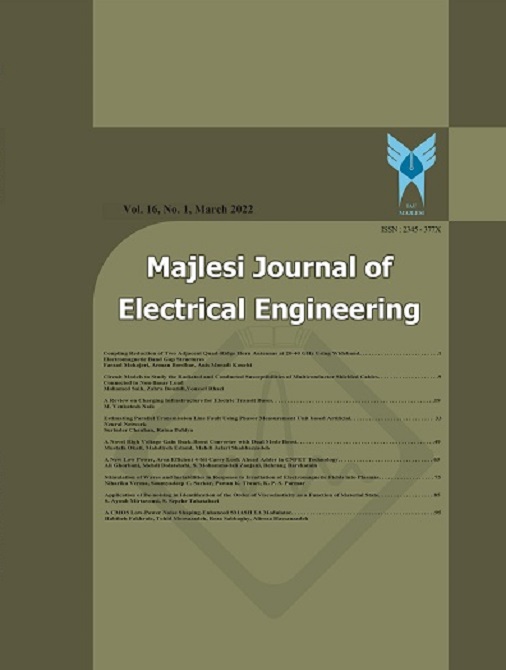[1] R. K. Varma, and S. Auddy, “Mitigation of Subsynchronous Oscillations in a Series Compensated Wind Farm with Static Var Compensator”, IEEE wer Engineering Society General Meeting, 2006.
[2] A. Rolan, A. Luna, G. R. Vazquez, D. Aguilar, and G. Azevedo. “Modeling of a Variable SpeedWind Turbine with a Permanent Magnet Synchronous Generator”. IEEE International Symposium on Industrial Electronics, 2009.
[3] P. Kundur, Power System Stability and Control. New York: McGraw-Hill, 1994.
[4] [4] L. A. S. Pilotto, A. Bianco, W. F. Long, and A. Edris, “IEEE Transactions on Power Delivery”, Vol. 18, No. 1, pp. 243 - 252, January 2003.
[5] [5] R. K. Varma, S. Auddy, and Y. Semsedini, “Mitigation of Subsynchronous Resonance in a Series-Compensated Wind Farm Using FACTS Controllers”, IEEE Transactions On Power Delivery, Vol. 23, No. 3, pp. 1645 - 1654, July 2008.
[6] [6]. IEEE Committee Rep., “First benchmark model for computersimulation of subsynchronous resonance,” IEEE Trans. Power Appl. Syst., vol. PAS- 96, no. 5, pp. 1565–1572, Sep./Oct. 1977.
[7] IEEE Subsynchronous Resonance Working Group, “Terms, definitions and symbols for subsynchronous oscillations,” IEEE Trans. Power Apparatus and Systems, vol. PAS-104, no. 6, pp. 1326–1334, 1985.
[8] K. R. Padiyar, Power System Dynamics: Stability and Control.Bangalore, India: Interline, 1996.
[9] IEEE SSR Working Group, Second Benchmark Model for Computer Simulation of Subsynchronous Resonance, IEEE Transaction on Power Apparatus and Systems. 104, No.5, PP.1057-1064, 1985.
[10] E. Uzunovic, C. A.Canizares, J. Reeve, “EMTP Studies of UPFC Power Oscillation Damping,” North American Power Symposium (NAPS) , San Luis Obisp o, California, October 1999.
[11] I.M. Hoseiny Naveh, E. Rakhshani, and R. Heidari, “Application of Linear Observer on Control of Subsynchronous oscillations Using TCSC,” IEEE, POWERENG, Lisbon, Portugal, pp. 540–545, March 2009.
[12] N. Muntean, O. Cornea, and D. Petrila, “A New Conversion and Control System for a Small off – Grid Wind Turbine,” 12th International Conference on Optimization of Electrical and Electronic Equipment, OPTIM, 2010.
[13] E. A. Gargari, and C. Lucas, “Imperialist Competitive Algorithm: An Algorithm for Optimization Inspires by Imperialistic Competition,” IEEE Congress on Evolutionary Computation, Singapore, 2007.
[14] A. M. Jasour, E. Atashpaz, and C. Lucas, “Vehicle Fuzzy Controller Design Using Imperialist Competitive Algorithm,” Second First Iranian Joint Congress on Fuzzy and Intelligent Systems, Tehran, Iran, 2008.
[15] N. Razmjooy, B. Somayeh musavi, B. Sadeghi, and M. Khalilpour, “Image Thresholding Optimization Based on Imperialist Competitive Algorithm,” 3rd Iranian Conference on Electrical and Electronics Engineering (ICEEE2011), 2011.
[16] J. Kennedy, R. Eberhart, “Particle swarm optimization,” in Proc.IEEE Int. Conf. Neural Networks, Vol. 4, Perth, ustralia, pp. 1942–1948, 1995.
[17] Q. Gu, A. Pandey, and S. K. Starrett, “Fuzzy Logic Control for SVC Compensator to Control System Damping Using Global Signal,” Electric Power Systems Research, Vol. 67, No. 1, pp. 115–122, 2003.
[18] H. He, “Fuzzy Modeling and Fuzzy Control [Book Review],” IEEE Computational Intelligence Magazine, 2008.
[19] R. C. Tatikonda , V. P. Battula, and V. Kumar, “Control of Inverted pendulum using Adaptive Neuro Fuzzy Inference Structure (ANFIS),” IEEE International Symposium on Circuits and Systems (ISCAS), pp. 1348 – 1351, 2010.
[20] A. Khosla, S. Kumar, and K.K. Aggarwal, “Fuzzy Controller for Rapid Nickel-Cadmium Batteries Charger through Adaptive Neuro-Fuzzy Inference System (ANFIS) Architecture,” 22nd International Conference of the North American, uzzy Information Processing Society, pp. 540 – 544, 2003.
[21] S. R. Khuntia, and S. Panda, “ANFIS Approach for TCSC-based Controller Design for Power System Stability Improvement,” IEEE International Conference on Communication Control and Computing Technologies (ICCCCT), pp. 149 – 154, 2010.

